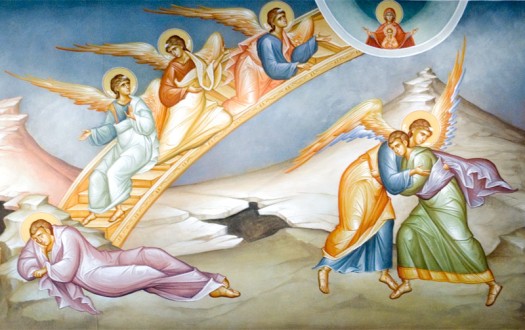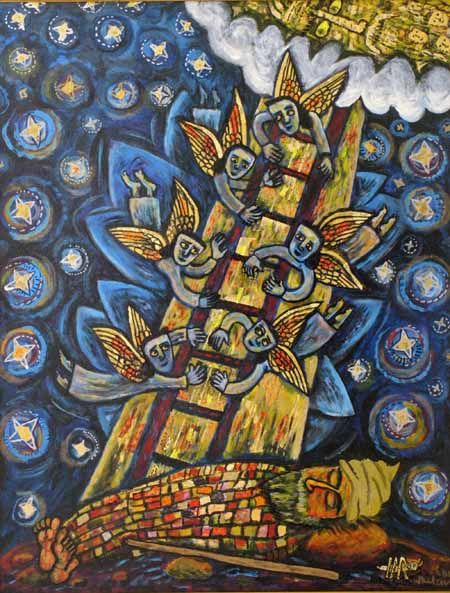On this First Sunday of Lent the Orthodox Church commemorates the restoration of icons in the year 843, after many decades of iconoclastic controversy. In the Liturgy we read John 1:43-51, and one can reasonably wonder what this Gospel reading has to do with the restoration of icons. I choose to dig into the symbols that abound in this Johannine pericope and reach my own understanding.
Let’s start with the fig tree – a common image in the Bible of peace, tranquility and material abundance.
1 Kings 4:25 During Solomon’s lifetime Judah and Israel lived in safety, from Dan even to Beer-sheba, all of them under their vines and fig trees.
Zechariah 3:10 On that day, says the Lord of hosts, you shall invite each other to come under your vine and fig tree.
The fig tree is the only tree actually identified in the garden of Eden, that place of original peace and harmony with God: Then the eyes of both were opened, and they knew that they were naked; and they sewed fig leaves together and made loincloths for themselves (Genesis 3:7). The fig leaves became a cover for the peace that was lost. So no wonder, the fig tree became a metaphor in the later scriptures for the peace that was longed for.
Jesus saw Nathanael sitting under a fig tree and calls him a true Israelite in whom there is no deceit – δόλος means treachery, deceit, trickery.
Who was Israel? Jacob in the book of Genesis – son of Isaac, grandson of Abraham. The Heb name yaʿăqōb is connected with Heb ʿāqēb, “heel,” because Jacob was born clutching the heel of his brother Esau (Genesis 25:26), and with the verb ʿāqab, “cheat,” because Esau said that Jacob had cheated him twice (Genesis 27:36). Jacob was the original trickster.
Not only did he trick his brother Esau, but Jacob also forced an angel to bless him!
Genesis 32:24-30 Jacob was left alone; and a man wrestled with him until daybreak. When the man saw that he did not prevail against Jacob, he struck him on the hip socket; and Jacob’s hip was put out of joint as he wrestled with him. Then he said, “Let me go, for the day is breaking.” But Jacob said, “I will not let you go, unless you bless me.” So he said to him, “What is your name?” And he said, “Jacob.” Then the man said, “You shall no longer be called Jacob, but Israel, for you have striven with God and with humans, and have prevailed.” Then Jacob asked him, “Please tell me your name.” But he said, “Why is it that you ask my name?” And there he blessed him. So Jacob called the place Peniel, saying, “For I have seen God face to face, and yet my life is preserved.”
So by calling Nathanael a true Israelite in whom there is no trickery, Jesus is initiating a new era, a new Israel, a clean break from the origins of Israel – a new birth. And the Jacob imagery continues at the end of the episode with Nathanael : you will see heaven opened and the angels of God ascending and descending upon the Son of Man. Heaven was closed, it was now open again.
Genesis 28:10-14 Jacob left Beer-sheba and went toward Haran. He came to a certain place and stayed there for the night, because the sun had set. Taking one of the stones of the place, he put it under his head and lay down in that place. And he dreamed that there was a ladder set up on the earth, the top of it reaching to heaven; and the angels of God were ascending and descending on it. And the Lord stood beside him and said, “I am the Lord, the God of Abraham your father and the God of Isaac; the land on which you lie I will give to you and to your offspring; and your offspring shall be like the dust of the earth, and you shall spread abroad to the west and to the east and to the north and to the south; and all the families of the earth shall be blessed in you and in your offspring.

Let’s bring all these images together to get a sense of what John’s Gospel is telling us here:
The promise to Jacob and Jacob’s children is now fulfilled. Nathanael is one of Jacob’s children – that’s the brunt of “true Israelite”. But unlike Jacob, the new Israelite in whom is no trickery, will not inherit the promises through trickery of deceit. Neither will the new Jacob, the new Israel, have to fight with God for access to God. The new Jacob is found under a fig tree, an image of peace and harmony, a return to Eden. The ladder that Jacob saw in a dream is no longer. The messengers of God no longer need a ladder – they now ascend and descend upon the Son of Man – the preposition epi: ἐπὶ τὸν υἱὸν τοῦ ἀνθρώπου. Heaven is once again open for business, as a friend of mine has put it. The ladder has been replaced by Jesus on earth, as the Son of Man, the Son of Humanity!

This is powerful and the ultimate transformation of religion. Three weeks from today we will observe the memory of John Climacus, John of the Ladder – famous writer of the Ladder of Divine Ascent, which became the most popular book for monks. But Jesus is not interested in ladders. Jesus is here on earth, a true son of humanity. It is through him that we enter heaven, it is through him that we become the new Jacob, the new Israel, in whom there is no trickery, no struggle with God. Jesus is the end of religion. And that, dear friends, is very much part of the lesson of today’s reading. Perhaps it is part of the meaning in having this reading in the first Sunday of Lent, on the very day in which we celebrate the restoration of icons. Much as icons are important in our tradition and spirituality, the ultimate icon is Jesus Christ himself. Colossians 1:15 ὅς ἐστιν εἰκὼν τοῦ θεοῦ τοῦ ἀοράτου, πρωτότοκος πάσης κτίσεως.
And every follower of Christ, every one who is a true Israelite, in whom there is no trickery or deceit, is also an icon – “seeing that you have put off the old nature with its practices and have put on the new nature, which is being renewed in knowledge after the image of its creator” κατ’ εἰκόνα τοῦ κτίσαντος αὐτόν (Colossians 3:9-10).
The ladder of human effort has been replaced by the icon of a human being fully alive. St Irenaeus of Lyons wrote, over 1800 years ago, “the glory of God is a human being fully alive.” Be alive in the glory of the Lord. Let is shine in you. Heaven is open to you today.
